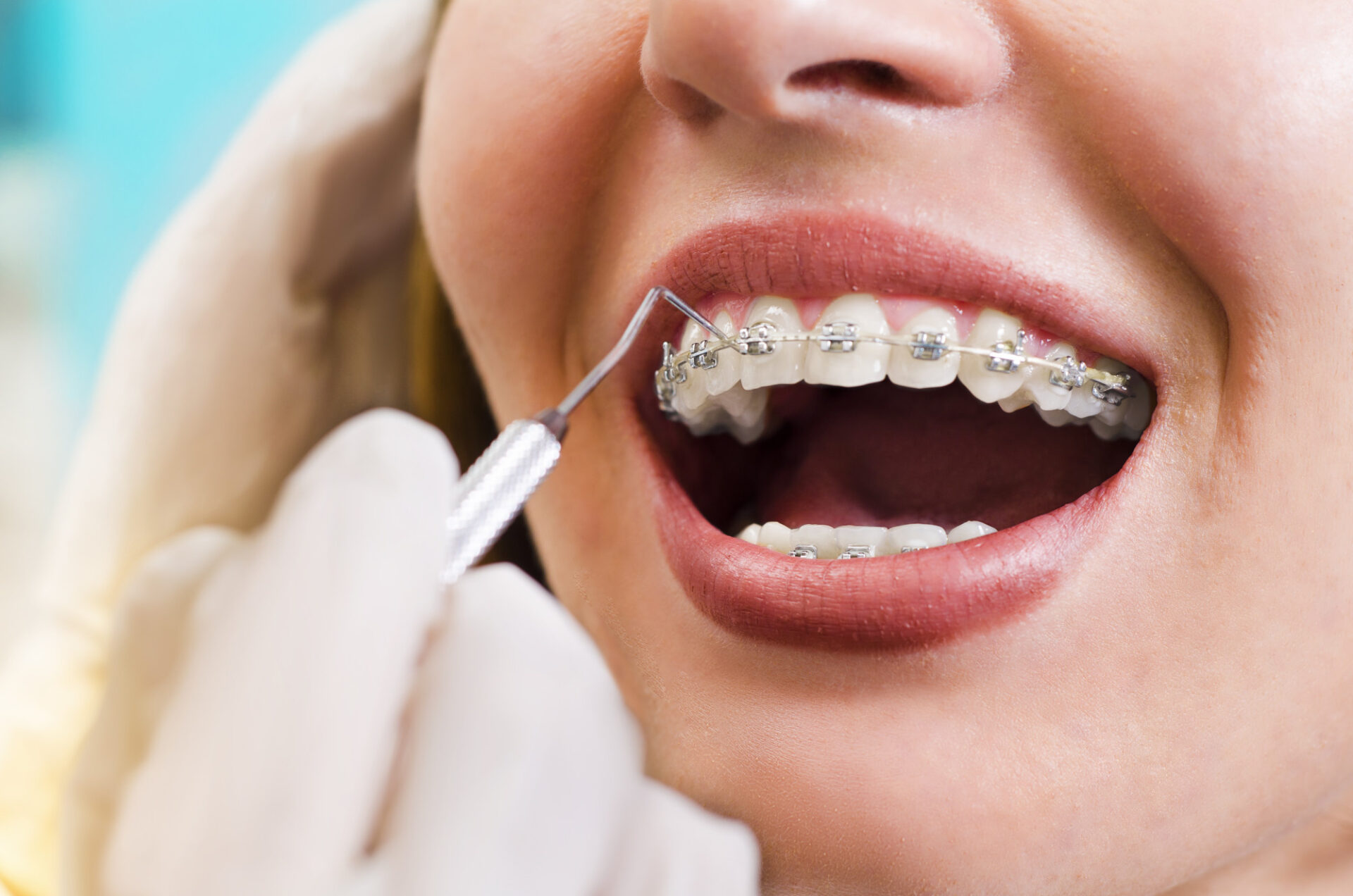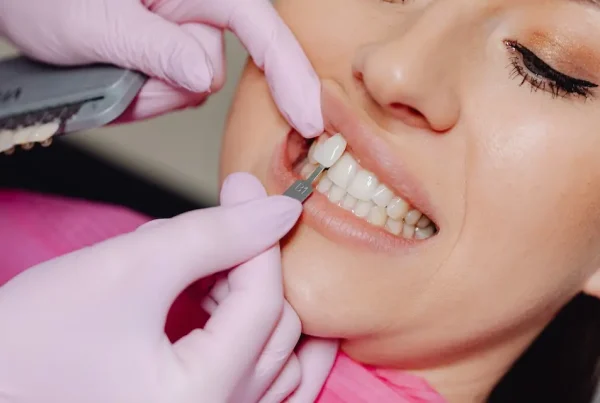
Orthodontic treatment corrects dental misalignments and achieves a more aesthetic smile. While metal braces have been a classic option for many years, ceramic (porcelain, transparent) braces have emerged as a more aesthetically appealing alternative in recent years. This article will examine the differences between metal and ceramic braces and help you determine which option is more suitable for you.
What Are Ceramic (Porcelain, Transparent) Braces?
Ceramic braces are an aesthetic alternative developed to traditional metal braces. Made from ceramic material, they have a color that blends with the teeth and is generally preferred by those who want to maintain the natural appearance of their teeth.
Ceramic braces are less noticeable than metal braces, making them an ideal option for those with aesthetic concerns. Additionally, ceramic braces provide less discomfort. Therefore, they are a popular choice for those who prioritize comfort.
What Are Metal Braces?
Metal braces are a traditional option commonly used in orthodontic treatment. Made of stainless steel, they consist of metal brackets placed on the front of the teeth and wire connections between them. Metal braces have a strong and durable structure, which can effectively correct the movement of teeth throughout the treatment process.
Metal braces are more resistant to decay and discoloration and generally carry a lower risk of breakage during treatment. Because of these features, they are a preferred option for many patients in need of treatment.
Advantages of Metal and Ceramic Braces
While metal and ceramic braces have different characteristics, both offer certain advantages in orthodontic treatment.
Advantages of Metal Braces:
- Durability: Metal braces are highly durable as they are made of stainless steel, effectively assisting in the correction of teeth throughout the treatment process.
- Economical: Metal braces are generally a more economical option and are more affordable regarding treatment costs.
- Effective Treatment: Thanks to their strong structure, metal braces can effectively control teeth movement and provide quick results.
Advantages of Ceramic Braces:
- Aesthetic Appearance: Ceramic braces are an ideal option for those with aesthetic concerns because they blend with the natural color of the teeth.
- Less Noticeable: They are less noticeable than metal braces, which is advantageous for those who want to conceal the treatment process.
- Comfort: Ceramic braces cause less discomfort than metal braces and can be more compatible with soft tissues.
Comparison of Metal and Ceramic Braces in Terms of Price
Metal and ceramic braces differ in price. Metal braces are generally considered a more economical option compared to ceramic braces. This is because the materials and technology used in the production of ceramic braces are more costly. While ceramic braces may be more attractive to patients with aesthetic concerns, they are generally more expensive than metal braces.
Metal braces are typically more affordable as they are more widely used and made with cheaper materials. However, prices may vary depending on the complexity of the treatment, the materials used, and the practitioner’s expertise. You can schedule a detailed discussion with your dentist to determine treatment costs.
Maintenance of Metal and Ceramic Braces
Proper maintenance is essential for both metal and ceramic braces to achieve long-term success. Both types require regular care, which ensures the effectiveness of the treatment process and prevents potential complications.
Maintenance of Metal Braces:
- Metal braces should be cleaned using tools such as a toothbrush, dental floss, and interdental brushes. Teeth should be brushed after every meal and before bedtime. It is recommended to avoid sugary and sticky foods, as they can cause plaque buildup around the braces. Regular dental check-ups should not be neglected.
Maintenance of Ceramic Braces:
- Ceramic braces should also be cleaned similarly to metal braces. A toothbrush, dental floss, and interdental brush should be used. Smoking and colored beverages should be avoided to prevent discoloration. It is recommended to refrain from consuming sticky and hard foods, as ceramic braces are more fragile. Regular dental check-ups should evaluate the condition of the braces.
Hygiene is essential for both braces as plaque buildup can lead to tooth decay and gum problems. Adhering to your dentist’s recommended oral care routines will positively affect the success and outcomes of the treatment.
Who Should Use Ceramic Braces?
Ceramic braces are an ideal option for many patients with aesthetic concerns who want to avoid the noticeable appearance of traditional metal braces. Adults and young adults especially may prefer ceramic braces to maintain their natural smiles while straightening their teeth.
Ceramic braces may also be suitable for teenagers. However, they may need to be more careful during treatment as ceramic braces can be slightly more fragile than metal braces.
Ceramic braces may be preferred in public and professional environments because they are less noticeable. Therefore, anyone with aesthetic concerns and a desire for a more natural appearance can consider ceramic braces.
After a detailed evaluation and examination with your dentist, you need to determine whether your dental structure and treatment needs are suitable for ceramic braces. Additionally, it is essential to be informed about ceramic braces’ maintenance and treatment requirements.
Who Should Use Metal Braces?
Metal braces are suitable for many patients, depending on their various situations and needs. They are generally more economical than ceramic braces, so they may be ideal for treatments with budget constraints or treatments that are not fully covered by insurance.
Metal braces may be more effective in some cases of teeth straightening. They may be stronger and more durable, especially for patients with severe dental misalignments or jaw problems. Metal braces can sometimes provide faster results. Patients who want to shorten the treatment time or achieve faster results may prefer metal braces.
Metal braces are more durable than ceramic braces, so they may be more suitable for physically active individuals or athletes. However, the suitability of metal braces depends on individual circumstances and treatment requirements. You can schedule a discussion with your dentist to determine the most suitable treatment option.
Are Metal Braces Risky?
Metal braces are generally considered a reliable and effective option for orthodontic treatment. However, there may be potential risks and concerns in some cases. Nickel, one of the materials used in metal braces, can cause allergic reactions in some individuals. In such cases, metal braces may cause allergic symptoms.
Metal braces can apply friction or pressure to the gums, cheeks, or lips. This can occasionally cause pain, irritation, and injuries. Additionally, friction against tooth enamel can lead to enamel erosion or wearing down of tooth enamel. This can make teeth more sensitive and vulnerable to decay.
Metal braces may cause discomfort or a feeling of a foreign object in the mouth for some patients. Especially during periods when the braces are frequently adjusted or changed, pain or discomfort may be experienced.
Most of these risks can be minimized when proper care is taken, and regular dental check-ups are attended. You can consult your dentist if you have any concerns about metal braces or want to learn what steps to take to reduce risks.





